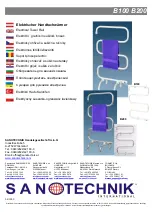
LP-446-r4 Rev. 10.12.16
32
D. Line Voltage Wiring for Standard Boiler
NOTE:
A termination plug is included in the CAT 3 / CAT 5 Bus
Connection Point, labeled J3 in Figure 26. DO NOT REMOVE
THIS PLUG! Doing so will affect boiler operation and void
warranty.
1. Connect the incoming power wiring to the line voltage
terminal strip in the electrical junction box at terminals 120V,
Neutral, Ground (shown in Figure 26).
2. A line voltage fused disconnect switch may be required,
externally mounted and connected according to local codes that
may apply.
3. If the pump used for the boiler operates at 120 volts and less
than 3 amps is required, it may be connected directly to the
terminals marked BOILER HOT, BOILER NEUT, and BOILER
GRD. If the pump operates at a voltage other than 120 volts and/
or requires more than 3 amps, an external motor starter must be
program of a 5 minute post purge to provide stabilization and
post cleaning of the heat exchanger. The boiler control is capable
of supplying 120 volts at up to 3 amps to run the circulator pump.
If using a larger circulator pump requiring more than 3 amps or
higher voltage, an external motor starter, sized appropriately
for the pump motor, must be used. This starter should have a
120 VAC coil. If a starter with a 120 VAC coil is used, it can be
wired directly to the appropriate pump terminals as shown in
Figure 26.
Tank and Sensor Connections
When the Mod Con VWH is used in a single tank installation, it
is recommended to use a sensor (7250P-325) placed in a well
in the storage tank for best temperature control. If multiple
tanks are used in the installation, it is recommended to put a
mechanical aquastat in each tank and wire them in series to
provide temperature control of the tanks. (See Applications
for reference.) The control in the Mod Con VWH will read
either the temperature of the tank sensor or the status of
the aquastats, and cause the boiler to run until the water
temperature of the tank(s) meets the desired set point.
If a sensor or aquastat cannot be placed directly in the tank,
then one sensor should be used on the pipe carrying water
from the tank(s) to the boiler. To minimize temperature
loss in the piping, this sensor should be placed as close
to the tank(s) as possible. The use of a pipe sensor will be
somewhat less accurate than using a sensor in the tank, and
has the disadvantage of requiring the boiler pump(s) to run
continuously so the sensor is always measuring the tank
water temperature.
In a multiple Mod Con VWH installation, where the boilers are
connected for cascade operation, a system sensor is needed
in addition to the tank or pipe sensor described above. The
system sensor is mounted on the common pipe to the tank(s)
from the boilers as close to the tank(s) as possible. The
purpose of this sensor is to serve as feedback to the control
and provide it with the aggregate temperature of all firing
boilers. The master boiler control will then fire the boilers in
cascade sequence to maintain the water temperature in this
pipe and provide correct tank heating.
The electrical junction box has separate, clearly marked
terminal strips for line voltage and low voltage wiring. Special
jacks are provided for trouble-free cascade system wiring
using standard CAT3 or CAT5 patch cables.
Figure 26 - VWH Control Wiring
used to operate the pump. If the starter is equipped with a 120
volt coil, the coil connections may be connected directly to
the terminals marked BOILER HOT and BOILER NEUT. Refer
to Figure 29 for a representative drawing of this configuration.
If a motor starter is used, it should be selected, installed,
and wired in compliance with all local electrical codes and
requirements. In the absence of such codes or requirements,
the National Electrical Code (NFPA 70) should be followed.
E. Alarm Connections
The control includes a dry contact alarm output. This is an SPDT
circuit, rated at 5 amps at 120 volts. This contact can be used to
activate an alarm light or bell or notify a building management
system if the boiler goes into a lockout condition. The circuit
between the ALARM COM and NC terminals is closed during
normal operation and the circuit between ALARM COM
and NO is open during normal operation. The connections
depicted in Figure 26 show two 120 volt lights connected to
Summary of Contents for MODCON500
Page 35: ...LP 446 r4 Rev 10 12 16 35 Figure 29 Cascade Master and FollowerWiring...
Page 57: ...LP 446 r4 Rev 10 12 16 57 Figure 35 500 Model Combustion System Replacement Parts...
Page 58: ...LP 446 r4 Rev 10 12 16 58 Figure 36 700 850 Models Combustion System Replacement Parts...
Page 60: ...LP 446 r4 Rev 10 12 16 60 Figure 38 Cabinet Replacement Parts All Models...
















































